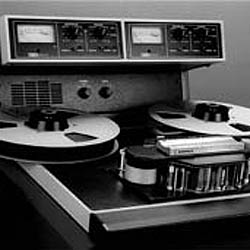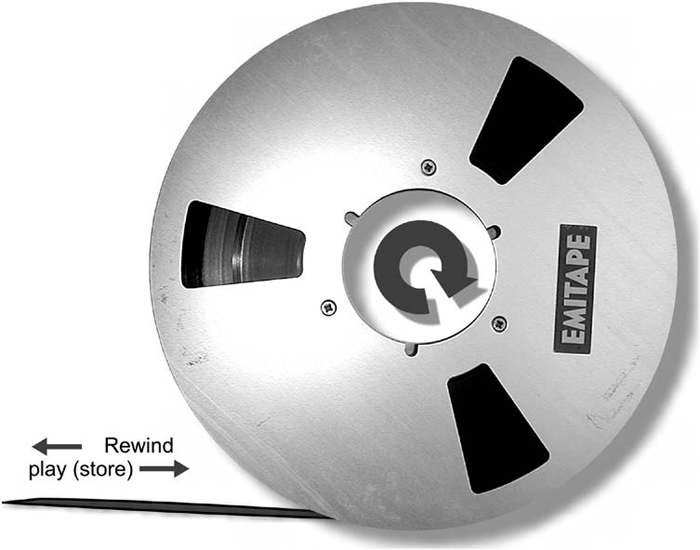
So why do we go through all this trouble? When a tape is stored tails-out (Figure 7), the print-through will bleed to the outer layers, a condition that causes the echo to follow the original signal in a way that’s similar to the sound’s natural decay and is subconsciously perceived by the listener as reverb instead of as an easily-audible pre-echo.
Cleanliness
It’s very important for the magnetic recording heads and moving parts of an ATR transport deck to be kept free from dirt and oxide shed.
Oxide shed occurs when friction causes small particles of magnetic oxide to flake off and accumulate on surface contacts.
This accumulation is most critical at the surface of the magnetic recording heads, since even a minute separation between the magnetic tape and heads can cause high-frequency separation loss.
For example, a signal that’s recorded at 15 ips and has an oxide shed buildup of 1 mil (0.001 inch) on the playback head will be 55 dB below its standard level at 15 kHz.
Denatured (isopropyl) alcohol or an appropriate cleaning solution should be used to clean transport tape heads and guides (with the exception of the machine’s pinch roller and other rubber-like surfaces) at regular intervals.
Degaussing
Magnetic tape heads are made from a magnetically soft metal, which means that the alloy is easily magnetized … but once the coil’s current is removed, the core won’t retain any of its magnetism.
Small amounts of residual magnetism, however, will build up over time, which can actually partially erase high-frequency signals from a master tape.
For this reason, all of the tape heads should be demagnetized after 10 hours of operation with a head demagnetizer. This handheld device works much like an erase head in that it saturates the magnetic head with a high-level alternating signal that randomizes residual magnetic flux.
Once a head has been demagnetized (after 5 to 10 seconds), it’s important to move the tool to a safe distance from the tape heads at a speed of less than 2 inches per second before turning it off, so as to avoid inducing a larger magnetic flux back into the head.
Before an ATR is aligned, the magnetic tape heads should always be cleaned and demagnetized in order to obtain accurate readings and to protect expensive alignment tapes.
Backup And Archive Strategies
In this day of hard drives, CDs and digital data, we’ve all come to know the importance of backing up our data. With important music and media projects, it’s equally important to create a tape backup copy in case of an unforeseen catastrophe or as added insurance that future generations can enjoy the fruits of your work.
Backing Up Your Project
The one basic truth that can be said about analog magnetic tape is that this medium has withstood the test of time.
With care and reconditioning, tapes that have been recorded in the 1940s have been fully restored, allowing us to preserve and enjoy some of the best music of the day. On the other hand, digital data has two points that aren’t exactly its favor:
- Data that resides on hard drives isn’t the most robust of media over time. Even CDRs (which are rated to last over 100 years) haven’t really been proven to last.
- Even if the data remains intact, with the ever-increasing advances in computer technology, who’s to say that the media, drives, programs, session formats and file formats will be around in 10 years, let alone 50!
These warnings aren’t slams against digital, just precautions against the march of technology versus the need for media preservation.

